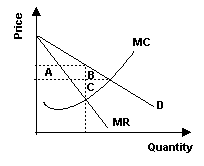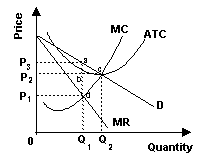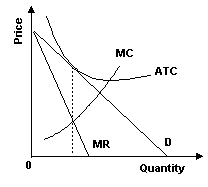
| 1. |
The law of demand states (everything else unchanged)
|
| 2. |
If there is an increase in the supply of a good,
|
| 3. |
(Repeat your answer on Scantron line 32.) An increase in the price of Ford cars will have what likely effect in the market for Honda cars?
|
| 4. |
If rent controls for apartments were established in Austin below the present going rental rates, we could expect
|
| 5. |
In the evolution of economic systems:
|
| 6. |
__________ came into existence in the mid-1700s while ________________ came into existence in the early 1900s.
|
| 7. |
(Repeat your answer on Scantron line 33.) What are the two largest sources of revenue for the federal government?
|
| 8. |
(Repeat your answer on Scantron line 34.) Evaluate the following statements.
1. The electric company charges higher prices for electricity during periods of peak demand in the summer, and lower prices at "off-peak" hours. This is evidence of price discrimination. 2. The local movie theater offers a student discount, even at peak times. This is evidence of price discrimination. 3. If a firm is practicing price discrimination, that firm has monopoly power.
|

| 9. |
In Figure X, if society wishes to eliminate the welfare cost of this monopoly by regulating it, the regulators will set a price so that
|

| 10. |
(Repeat your answer on Scantron line 35.) Select the best answer after evaluating the following statements. Refer to the figure above as needed.
1) If price discrimination is not possible, this monopolist will choose the monopoly price ph (the highest price of the four choices shown) and output level "a". 2) If this monopolist is able to price discriminate by charging two different prices, one being the original monopoly price and the second being price pl, then society's "efficiency cost" (welfare cost) from this monopoly will be smaller than if the monopolist had to charge just one price. 3) If this firm must charge just one price, and if society wishes to eliminate the "efficiency cost" of this monopoly, this can be accomplished by forcing the price down to price pm.
|
| 11. |
(Repeat your answer on Scantron line 36.) Evaluate the following statements and then choose from A) through E)
1) The Wealth of Nations was written by Milton Freidman. 2) The Wealth of Nations was written by John Maynard Keynes. 3) The Wealth of Nations was published just after the Great Depression. 4) Adam Smith is a famous economist who wrote in the mid 1800's.
|
| 12. |
A primary goal of the World Bank is to
|

| 13. |
(Repeat your answer on Scantron line 37.) Refer to the graph above. Which area represents the welfare loss due to a monopolist?
|
| 14. |
As you slide down a straight line demand curve:
|
| 15. |
(Repeat your answer on Scantron line 38.) Suzy has just finished her economics exam and must decide whether to spend two hours going to the sauna, having a couple of margaritas, or going to a movie. She can do one, all, or any two of these things. The question is, what should she do? Here is the data: The marginal utility of the sauna is 36 utils and the price is $6. The marginal utility of the two margaritas is 24 utils and the price is $4 for two margaritas. The marginal utility of going to the movie is 40 utils and the price is $10. Suzy's marginal utility of a dollar is 5 utils per dollar. Choose the best answer from A) through E).
|
| 16. |
(Repeat your answer on Scantron line 39.) A firm has average variable costs of $60 per unit, average fixed costs of $40 per unit and can sell its output at $50 per unit.
|
| 17. |
(Repeat your answer on Scantron line 40.) The welfare cost (also known as the efficiency cost) of a monopolist which charges a single price
|
| 18. |
Economic profit is defined in the text as "revenues minus implicit and explicit costs". By implicit costs, the author is referring to:
|
| 19. |
As a result of advances in productivity, farmers can now produce more at a lower cost, but the demand for agricultural goods is very inelastic. Therefore the effect of these changes has been to __________ for farmers as a group.
|
| 20. |
(Repeat your answer on Scantron line 41.) If the income elasticity of demand for a good is larger than zero, the good is:
|
| 21. |
(Repeat your answer on Scantron line 42.) Decide which of the following statements are definitely true or false and then choose the best answer from among A) through E) below. The Fundamental Theorem of Welfare Economics tells us that:
1) Only a fundamentally fair economic system will be politically and economically stable. 2) If certain somewhat techinical conditions are valid, economic systems will be maximally efficient if all markets are competitive and the problems of externalities and public goods have been properly dealth with. 3) As a practical matter, no economic system can hope to be efficient unless government takes an active role in managing the complexities of the modern economy. 4) Welfare is maximized, in the Pareto sense, by appropriate welfare programs which are best undertaken by the federal and local governments rather than by the state governments. Choose the best answer:
|
| 22. |
You are studying a "well-run firm" which produces electric motors. You know the price of rotors is $2 per rotor, and the marginal product of rotors is 1 motor per rotor. You also know the firm uses electricians, and the salary of electricians is $20 per hour. What is the marginal product of electricians in this firm?
|
| 23. |
(Repeat your answer on Scantron line 43.) Based on our analysis in lecture using the "labor-leisure choice" model, choose the best answer from among the following statements about government wellfare programs.
|
| 24. |
(Repeat your answer on Scantron line 44.) Based on what you learned in lecture, consider whether each of the following statements 1 through 7 describes part of the data needed to calculate the number of firms in a competitive industry. Then select the best answer from A through E below.
1) The value of marginal cost at the lowpoint of the long run marginal cost curve of the typical firm. 2) The level of output at the lowpoint of the long run marginal cost curve of the typical firm. 3) The level of output at the lowpoint of the long run average cost curve of the typical firm. 4) The value of short run marginal cost at the lowpoint of the short run marginal cost curve of the typical firm. 5) The value of long run average cost at the lowpoint of the long run average cost curve of the typical firm. 6) Total industry demand at a price equal to the lowpoint of the long run average cost curve of the typical firm. 7) Total industry demand at a price equal to the lowpoint of the long run marginal cost curve of the typical firm.
|
| 25. |
(Repeat your answer on Scantron line 45.) Based on both text and lecture, decide which of the following numbered statements about monopolistic competition are correct and then choose the best answer from among A through E below:
1) Firms in monopolistically competitive markets are not expected to earn as high an economic profit as firms with monopolies. 2) Monopolistic competition is a type of market in which the goods of individual producers differ in some of the individual features they possess, but there are many sellers of goods possessing at least a basic list of features in common, and there is easy entry into the markets in the long run. 3) In monopolistically competitive markets, firms are able to capture a permanent monopoly profit by inventing and incorporating a unique feature into the basic good, so they earn a monopoly profit, the same as monopolists. 4) Based on information from the text, firms in monopolistically competitive markets earn zero economic profit in the long run, the same as in perfectly competitive markets.
|
| 26. |
The average cost of producing electronic calculators in a factory is $20 at the current output level of 100 units per week. If fixed cost is $1200 per week:
|
| 27. |
If the price elasticity of demand equals 1.5 and the price elasticity of supply equals .5 then:
1) The sellers bear 25% of the burden. 2) The buyers bear 25% of the burden. 3) The sellers bear 75% of the burden. 4) The buyers bear 75% of the burden. 5) The buyers bear 1/3 of the burdent.
|

| 28. |
(Repeat your answer on Scantron lines 46 and 47.) Refer to the graph above. Which of the following statements about the market represented is true?
|

| 29. |
(Repeat your answer on Scantron line 48.) Refer to the graph above. The monopolist represented is:
|
| 30. |
(Repeat your answer on Scantron line 49.) Without barriers to entry:
|

| 31. |
(Repeat your answer on Scantron line 50.) The average variable cost (AVC) curve is labeled:
|
Answer Key
| 1. | D |
| 2. | C |
| 3. | B |
| 4. | A |
| 5. | D |
| 6. | C |
| 7. | D |
| 8. | B |
| 9. | C |
| 10. | B |
| 11. | A |
| 12. | B |
| 13. | C |
| 14. | E |
| 15. | C |
| 16. | B |
| 17. | E |
| 18. | B |
| 19. | E |
| 20. | C |
| 21. | E |
| 22. | B |
| 23. | C |
| 24. | C |
| 25. | E |
| 26. | D |
| 27. | A |
| 28. | C |
| 29. | C |
| 30. | D |
| 31. | B |